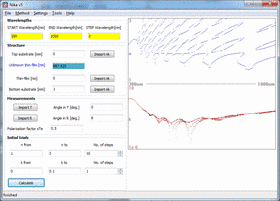^
Overview

Nika is the tool that helps you to extract the wavelength dependent complex refractive of unknown material and its thickness. It is based on RT method and our new innovative approach.
Key features
- Determine the refractive index from Reflectance (R) and Transmittance (T) or any other combination (RR, RT & TT) under arbitrary angle.
- Fully automated.
- Good alternative to expensive ellipsometry.
- Does not need approximation of dispersion function.
- Can be used for ANY isotropic and flat material.
Trial version
Not available.
^
Description
Applicability
The model is applicable to any kind of solid or liquid material, thin or thick. The program can also takes into account the supporting layers such as glass for solid materials or cuvette for liquids. The supporting layers can be characterized prior the main measurement to improve the accuracy.
Model
The model calculates the reflectance and transmittance from the propagation equations for the thin and thick layers (coherent and incoherent propagation of light). By providing the measurement for R and T the program extract the complex and wavelength dependent refractive indices of unknown material. The main advantage of our model and approach, compared to other methods is that no physical models for n and k of the material are required to obtain the solutions. Further on, the method also enables to determine the thin-film thickness to its accurate value, thus only the rough estimation of thickness is required.



